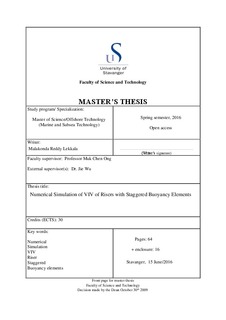| dc.contributor.author | Lekkala, Malakonda Reddy | |
| dc.date.accessioned | 2016-09-28T12:35:12Z | |
| dc.date.available | 2016-09-28T12:35:12Z | |
| dc.date.issued | 2016-06-15 | |
| dc.identifier.uri | http://hdl.handle.net/11250/2411424 | |
| dc.description | Master's thesis in for Offshore technology: Marine and subsea technology | nb_NO |
| dc.description.abstract | Steel Lazy Wave Riser (SLWR) is an attractive deep water riser system design, which allows the platform motion to be decoupled from the touchdown point (TDP) of the riser. When subjected to external flow, both buoyancy element and bare riser section may experience Vortex Induced Vibrations (VIV). Such vibrations are the results of the periodic hydrodynamic forces that are induced by the interaction of slender bodies and external fluid flow. If the vibration period is close to the natural period of the system, it can lead to fast accumulation of fatigue damage to the risers and amplified drag loads. The vortex shedding frequency of the buoyancy element is lower than that of the bare riser section due to its larger diameter. These two shedding process will interact and influence the VIV responses. Such interaction depends on many parameters, e.g. Buoyancy element dimensions and their arrangement etc.
Semi-empirical VIV prediction programs, such as VIVANA, SHEAR7 and VIVA are the most commonly used industrial VIV prediction tools. These programs rely on hydrodynamic force coefficient database generated from forced motion test with a rigid cylinder section. However, these database may not be valid for a flexible cylinder with buoyancy elements. Therefore, there are strong needs to obtain force coefficient database, taking into account the influences of the riser and buoyancy element interaction. In present work, the existing riser with staggered buoaycny VIV model test is reviewed. The prediction using VIVANA with default hydrodynamic force coefficient database is evaluated. A new way of obtaining an optimal database directly from VIV tests of a flexible cylinder with staggered buoyancy element is investigated. The hydrodynamic force coefficient database is parameterized and the representative parameters are systematically varied until the predicted frequency, mode and fatigue damage agree with experimental results. The improvements and uncertainties are also discussed. | nb_NO |
| dc.language.iso | eng | nb_NO |
| dc.publisher | University of Stavanger, Norway | nb_NO |
| dc.relation.ispartofseries | Masteroppgave/UIS-TN-IKM/2016; | |
| dc.rights | Navngivelse 3.0 Norge | * |
| dc.rights.uri | http://creativecommons.org/licenses/by/3.0/no/ | * |
| dc.subject | offshore teknologi | nb_NO |
| dc.subject | undervannsteknologi | nb_NO |
| dc.subject | VIV | nb_NO |
| dc.subject | numerical simulation | nb_NO |
| dc.subject | riser | nb_NO |
| dc.subject | staggered | nb_NO |
| dc.subject | buoyancy elements | nb_NO |
| dc.subject | marin og undervannsteknologi | nb_NO |
| dc.title | Numerical Simulation of VIV of Risers with Staggered Buoyancy Elements | nb_NO |
| dc.type | Master thesis | nb_NO |
| dc.subject.nsi | VDP::Technology: 500::Marine technology: 580::Offshore technology: 581 | nb_NO |

